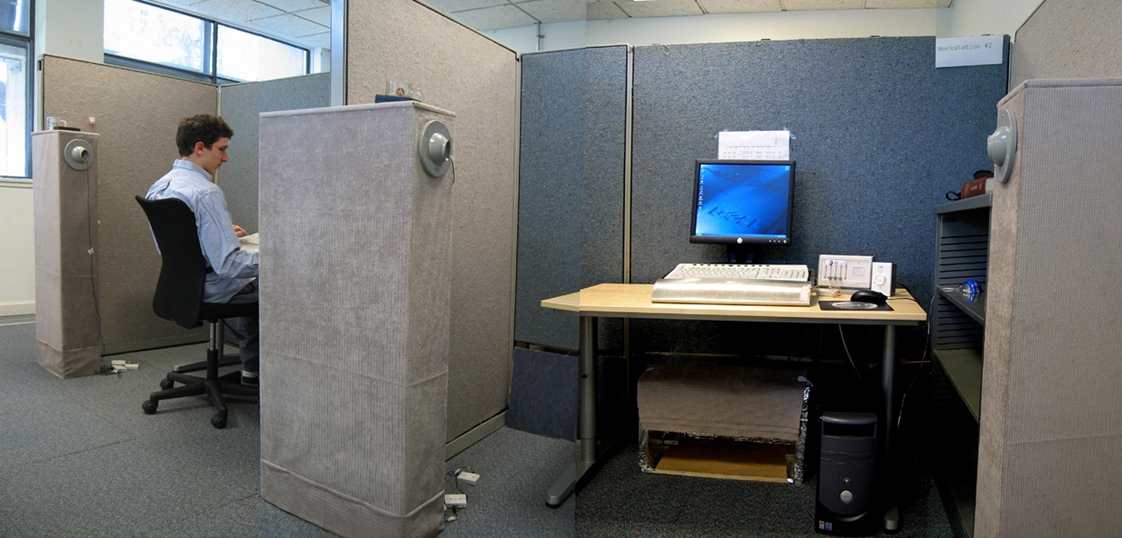Personal comfort systems may increase comfort and productivity while reducing building energy use.
Status: Completed
Funding Sources: CBE Industry Consortium Research Grants
Project Objective
Obtain scientific quantification of two environmental conditions that are most promising for a low-power task-ambient conditioning (TAC) system. By quantifying the effects of these conditions on comfort, we can propose new HVAC system designs and operating strategies. This fundamental human subject research may have a significant influence on peak demand and energy conservation in buildings, and provide specifications for the building control systems. We intend to target our findings to ASHRAE Standards 55 in order to enable a transformation in the building industry toward task-ambient conditioning systems.
Project Results
Analysis of the tests show that by adjusting the TAC system, occupants can be comfortable at a wide range of room ambient temperatures, from 64ºF (18 ºC) to 86 ºF (30 ºC). In addition, with the non-uniform environments created by the TAC devices, task performance did not decrease. In fact, in some cases task performance was better with the TAC system than under the neutral conditions. The perception of good air quality was also improved by providing more air motion in some conditions, even if it was simply re-circulated room air.
Instead of air-conditioning an entire space to a tightly limited range of temperatures as a conventional HVAC system does, the TAC systems will allow for a wider range of acceptable conditions.Energy modeling with EnegyPlus showed that energy savings compared to conventional HVAC systems could be as high as 60% in a climate such as Oakland, CA. The smallest savings occurred when the climate is very cold, such as winter in Minneapolis.
Results of the study were published in January of 2008.
Significance to Industry
The environmental control of buildings consumes close to 40% of the nation’s energy, and affects virtually the entire population in terms of comfort, and cost. Since the early days of air-conditioning, thermal comfort studies have focused on defining the temperature ranges that make people feel thermally neutral and that therefore avoid discomfort. However several recent studies suggest a new perspective to thermal comfort, looking at asymmetry and transience as more than just a disturbance of neutrality. An appropriate asymmetry may possibly produce better comfort than uniform neutrality because the different sensations from various body parts remove each other’s thermal stress and therefore are appreciated. Recent CBE studies have shown that head cooling especially can not only effectively remove heat, but also provide a higher level of comfort (Zhang 2003).
In combination with these comfort studies, advances in sensor-nets and user-interface technologies provide us an unprecedented ability to improve comfort and reduce energy cost, by implementing new HVAC systems that incorporate these technologies in task-ambient systems. Such highly developed systems have not been possible using existing HVAC control systems, and could not be evaluated accurately using simplified concepts of human comfort that have been used for designing such existing systems. With increased information flow from sensors and occupants, HVAC can be disruptively improved, to the benefit of building occupants, owners and facility managers.
Research Approach
CBE’s comfort model predicts that the local thermal comfort of feet, hands, and face determines overall body comfort in warm and cool conditions. We took advantage of this by designing a TAC system that heats only the feet and hands, and cools only the hands and face, to provide comfort in a wide range of ambient environments. Per workstation, the TAC system uses a maximum of 41W for cooling and 59W for heating. By reducing the amount of control normally needed in the overall building, it could be possible to save much larger amounts of energy in the building HVAC system.
The TAC system was tested on 18 subjects in our environmental chamber, at temperatures representing a wide range of practical winter and summer conditions (18-30ºC, or 65-86 ºF). A total of 90 tests were done. We measured subjects’ skin and core temperatures, obtained their subjective responses about thermal comfort, perceived air quality, and air movement preference. We had the subjects perform three different types of tasks to evaluate productivity of white-collar-type tasks during the test.
Publications and Reports
Zhang, H., D. Kim, E. Arens, E. Buchberger, F. Bauman, and C. Huizenga, 2008. Comfort, Perceived Air Quality, and Work Performance in a Low-Power Task-Ambient Conditioning System, CBE Summary Report, April. 45 pp.
Presentations
Zhang, H., et. al., 2005. Project presentation. October 27.

